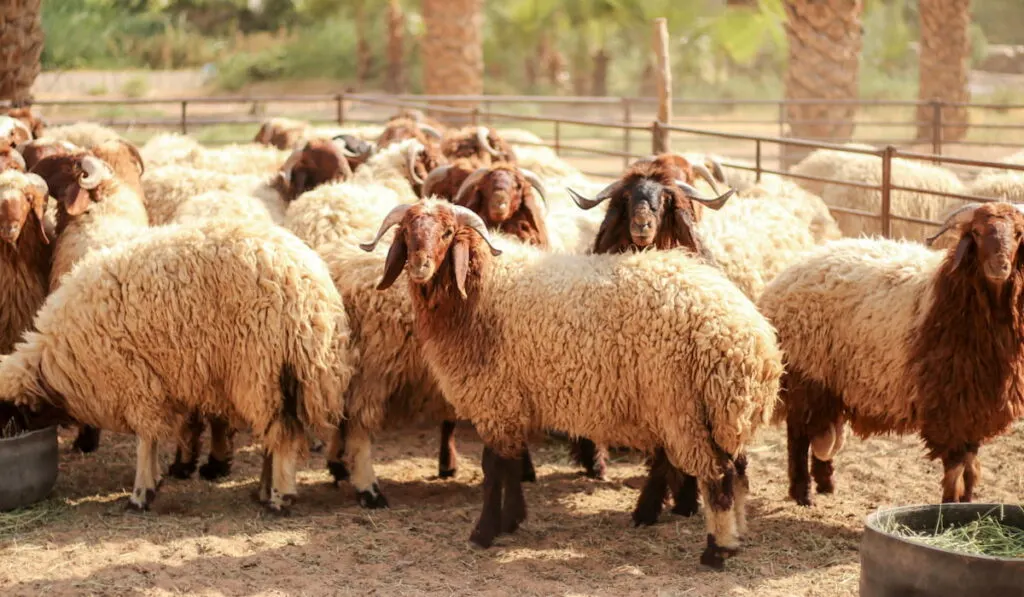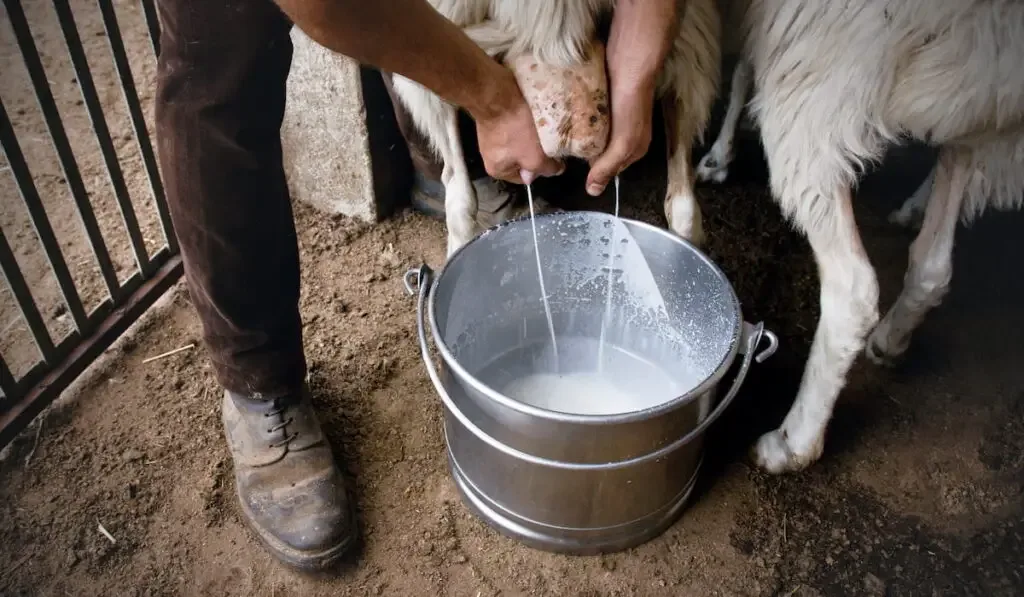Are you an aspiring sheep dairy farmer? Then you must be looking for the best sheep breeds for milk. Rearing dairy sheep is rewarding as the milk produced has many uses.
There are some important things you need to know before purchasing your flock of sheep.
What makes certain breeds good milk producers? Which ones will make it easier for you to provide fresh milk on demand at home or in your local community?

It is crucial to choose the right sheep breed to get the most out of sheep farming.
Choosing the best sheep breed is important because some breeds produce more milk than others, some milk more or less continuously, some can be sheared while lactating, some give birth to twins, while others only produce a single offspring at a time.
Here are some sheep breeds you may consider when looking for dairy sheep breeds.
1. East Friesian

The East Friesian breed is the highest milk producer with the most prolonged lactation period among the other sheep breeds.
Although they hold the title of excellent milk producer, these native breeds from Germany are fragile breeds that need specialized care. To get a hardy breed, East Friesians are usually crossed with other meat breeds. The ewes will produce more milk if you give them a high-quality diet.
- Approximate milk quantity: 79 to 158 gallons over a 200-300 day lactation period.
- They are mainly kept for their milk.
2. Lacaune

This breed hails from Lacaune, France, and produces a good amount of milk per year. They are a hardy breed, and their milk is used to make the most popular cheese- Roquefort cheese.
This breed is second to East Friesian in milk production.
Their milk has a great flavor, high protein content, and high butterfat content. Selective breeding has led to better milk production from the Lacaune Sheep.
- Approximate milk quantity: 48 gallons in a 160 days lactation period.
- They are also kept for their wool.
3. Assaf
The Assaf sheep breed is a cross between East Friesian and Awassi. It was developed in the 1950s in Israel.
It has superior milk production with excellent cheese production. The Assaf breed became available in the USA in 2013 and is the preferred sheep breed compared to Awassi.
- Approximate milk quantity: 88 gallons in a 173 day lactation period.
- Also kept for their meat.
4. Awassi

Awassi sheep are hardier than the Lacaune and East Fresian sheep breeds. This breed was developed in a harsh environment in the Middle East and is thus very efficient in converting its feed to milk.
- Approximate milk quantity: 18-21 gallons over 150 days lactation period. Improved Awassi breed produces 133 gallons over a 214 day lactation period.
- Also kept for their wool and meat.
5. British Milk Sheep

This breed was produced by crossbreeding four different sheep breeds. The British Milk Sheep was initially known as Alderbred and was bred in harsh and rugged conditions to make them robust and hardy.
British Milk Sheep is a good milk producer, with the male sheep known to produce high-performance crossbreeds. The milk from the ewe contains 6% protein and 6% percent fat.
- Approximate milk quantity: 66 to 105 gallons over a 210 day lactation period.
- Also kept for their meat.
6. Chios Sheep
Chios sheep is a semi-fat tail breed that is kept for their milk. The milk from this sheep breed is used in making cheese such as Batzoz, Feta among others. Chios Sheep mature faster and thus are mated faster than other breeds.
- Approximate milk quantity: 120 to 272 liters over a 210 lactation period.
- Mainly kept for their milk.
7. Icelandic Sheep

The Icelandic sheep is a hardy breed of Northern European origin. However, this breed doesn’t do well in flocks as they are aggressive and dominating towards other breeds. They can still produce enough milk from eating less fodder. This breed is not used for commercial milk purposes but can serve the needs of a homestead.
- Approximate milk quantity: 1 liter per day for 180 days.
- Also kept for their wool and meat.
8. Bergamasca Sheep

Even though this breed is not up to what many consider to be the dairy standard, Bergamasca Sheep has been serving the needs of many Icelandic people as the primary source of dairy, meat, and wool.
They are a hardy breed that roams free in search of food in the harshest winter weather and still provides milk for cheese making.
- Approximate milk quantity: 42 to 47 gallons for about six months.
- Also kept for their wool and meat.
9. Clun Forest Sheep
Clun Forest sheep is a multi-purpose breed kept for its meat, wool, and milk. They are highly fertile and productive. They produce rich milk with high butter content which makes their lambs grow faster.
They are hardy and require low maintenance in addition to being good foragers. Clun Forest Sheep has good mothering abilities and usually produces twins. They are a multipurpose breed kept for their wool, meat, leather, and milk.
- Approximate milk quantity: one quarter gallon a day for about 130 to 150 days lactation period.
- Also kept for their meat and wool.
10. Bovec Sheep
The Bovec Sheep is a multi-purpose sheep raised for both milk and meat. This breed is a native of Slovenia with an average weight that is well adjusted for feeding on steep slopes. Mostly succulent grasses grow on these slopes, and thus the milk Bovec Sheep produce contains a distinctive taste.
This milk is used in making excellent Bovec Cheese.
- Approximate milk quantity: 53 gallons over a six month lactation period.
- Also kept for their meat.
11. Karayaka Sheep
Karayaka Sheep is a dual-purpose sheep breed native to Turkey. It is used for milk, meat, and wool (for making Carpets). Karayaka Sheep is a hardy breed suited for its local climate.
The ewes have a lactation period of about 130-140 days.
- Approximate milk quantity: 10 to 13 gallons over a lactation period of 130 to 140 days.
- Also kept for their meat and wool.

How To Pick a Dairy Sheep
When choosing a dairy sheep breed, you should consider many factors, one being the ram breed.
Male sheep do not produce milk, but they still play a very important role in sheep milk production. The ram’s job is to ensure the females get pregnant. A good ram breed will ensure that you get plenty of mil and a hardy offspring with better milk production, wool, and meat.
How can you choose a ewe that will be beneficial to you? When you purchase a dairy sheep, you may simply lose focus and buy what is not a milk breed. Here is a simple buying guide you can consider while at it.
Check The Udders
The sheep’s udders should be flexible and soft with two teats. Extra teats are considered blind as they have no outside opening and may cause a sheep to suffer from mastitis.
Feel the udder and check for any scar tissues and lumps that may indicate previous rounds of mastitis, which tends to recur.
Carefully Choose Your Breed
Dairy breeds will offer more prolonged lactation than non-dairy breeds. Non-dairy sheep breeds’ lactation can last for about three to five months, while dairy sheep breed’s lactation can last about eight months. Dairy sheep breeds will produce more milk per milking session, while non-dairy sheep breeds will produce far less.
The dairy sheep breeds are an excellent source of milk for cheesemaking and soapmaking. Their milk is highly nutritious, rich, creamy, and better tasting. Sheep milk has smaller fat globules, thus it is easier to digest.
Sheep milk contains:
- Calcium
- Magnesium
- Conjugated linoleic acid
- Vitamins A, B, and E
Sheep milk is of much superior quality compared to a cow’s or a goat’s milk.

Pure Dairy Sheep Breeds Versus Mixed Dairy Sheep Breeds
When you compare pure breeds with mixed breeds, mixed breeds tend to offer higher milk production.
If you are thinking of raising dairy sheep for commercial purposes, you should look for mixed dairy breeds. They are also hardy and thus won’t get sick more often.
Final Thoughts
When you choose to indulge in dairy sheep farming, you will find it very rewarding.
You will benefit from their rich milk, their wool, and their meat. The lambs mature faster and also attain market weight when they are just five months old.
This means that you will get quick returns on investment. Since they can also feed on dry pasture, you will not have difficulty tending to your flock.
Sources:
- https://morningchores.com/buying-sheep/
- https://culturecheesemag.com/farm-animal/lacaune-sheep/
- https://www.britishmilksheep.com/
- https://en.wikipedia.org/wiki/British_Milksheep
- https://en.wikipedia.org/wiki/Clun_Forest_sheep
- https://www.travel-slovenia.si/slovenian/bovec-sheep/
- https://www.roysfarm.com/karayaka-sheep/
- https://pubmed.ncbi.nlm.nih.gov/15483153/
- https://pubmed.ncbi.nlm.nih.gov/21509455/
